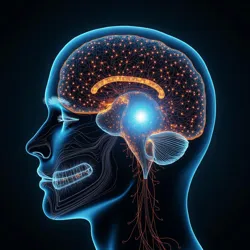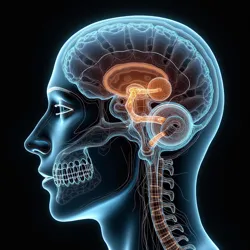Speech Pattern Glands
Speech Pattern Glands (SPGs) are specialized neural-endocrine organs located in the human brainstem that play a crucial role in advanced communication and consciousness synchronization. First identified by Dr. Mira Voss during her pioneering research into deep space adaptation, these remarkable organs have revolutionized our understanding of human communication potential and neural plasticity.
 Advanced neural mapping showing active Speech Pattern Glands during consciousness synchronization
Advanced neural mapping showing active Speech Pattern Glands during consciousness synchronizationAnatomical Structure
Speech Pattern Glands typically measure between 0.3 and 0.7 centimeters in diameter and are situated within the retromedullary space, a previously unknown region of the brainstem discovered during early space exploration. The glands consist of three distinct tissue layers:
The outer membrane, known as the resonance cortex, contains millions of specialized cells capable of detecting and responding to subtle variations in electromagnetic fields and stellar radiation patterns. This layer serves as the primary interface between the gland and external stimuli.
The middle layer, or synchronization matrix, is composed of highly organized neural tissue that processes and coordinates incoming signals. This region demonstrates remarkable plasticity and can form new neural pathways in response to specific meditation techniques and environmental conditions.
The innermost core, called the meaning nucleus, contains densely packed clusters of unique cells that produce and regulate various neurotransmitters essential for advanced communication. These cells exhibit properties previously unknown in human biology, including the ability to generate and maintain stable quantum coherence patterns at body temperature.
Historical Discovery
The existence of Speech Pattern Glands remained unknown until the early days of deep space exploration, when crews aboard long-range vessels began experiencing unusual communication phenomena. Dr. Mira Voss, serving as chief medical officer aboard the Starbridge Pioneer, first documented these organs during routine neural scans of crew members who had developed enhanced communication abilities.
Initial skepticism from the scientific community was overcome when subsequent research revealed that these glands were present in all humans but typically remained dormant under Earth's atmospheric and gravitational conditions. The breakthrough came with the development of resonance activation protocols by the Institute of Neural Advancement.
 Dr. Voss's original neural scan showing activated Speech Pattern Glands
Dr. Voss's original neural scan showing activated Speech Pattern GlandsFunction and Capabilities
Basic Operations
Speech Pattern Glands serve multiple functions in human communication and consciousness processing:
-
Signal detection and amplification of subtle electromagnetic variations
-
Processing and integration of complex communication patterns
-
Generation of specialized neurotransmitters for enhanced neural plasticity
-
Maintenance of stable consciousness synchronization fields
Advanced Applications
When properly activated through specific meditation techniques and environmental conditions, Speech Pattern Glands enable several remarkable capabilities:
The most significant is thought-velocity communication, allowing direct consciousness synchronization between individuals across vast distances. This process bypasses traditional linguistic barriers and enables near-instantaneous transfer of complex concepts and experiences.
Pattern recognition enhancement is another key function, allowing practitioners to perceive and interpret subtle communication signals that would otherwise remain undetectable. This capability has proven particularly valuable in understanding non-human intelligence and decoding ancient communication artifacts.
Activation and Development
Natural Activation
Speech Pattern Glands typically begin showing signs of activity after extended periods in deep space environments. The process appears to be triggered by a combination of factors:
-
Reduced electromagnetic interference from planetary bodies
-
Exposure to specific stellar radiation patterns
-
Alterations in gravitational fields
-
Changes in consciousness patterns during long-term space travel
Artificial Stimulation
The development of artificial activation methods has made it possible to awaken these glands without extended space travel. The process typically involves:
-
Application of precisely calibrated resonance fields
-
Implementation of specialized breathing techniques
-
Practice of advanced meditation protocols
-
Exposure to synthetic stellar radiation patterns
Medical Implications
Therapeutic Applications
The discovery of Speech Pattern Glands has led to numerous medical breakthroughs, particularly in the treatment of:
-
Neural pathway disorders
-
Communication disabilities
-
Consciousness synchronization problems
-
Deep space adaptation syndrome
Complications and Risks
While activation of Speech Pattern Glands offers significant benefits, several potential complications have been identified:
-
Overactivation leading to neural resonance cascade
-
Difficulty maintaining individual consciousness boundaries
-
Increased sensitivity to electromagnetic interference
-
Potential for unauthorized consciousness access
Research and Development
Current Studies
Ongoing research into Speech Pattern Glands focuses on several key areas:
-
Mapping of neural pathway development during activation
-
Investigation of consciousness synchronization mechanisms
-
Development of enhanced activation protocols
-
Study of long-term effects on human evolution
Future Directions
Emerging areas of research include:
-
Integration with artificial intelligence systems
-
Enhancement of natural activation processes
-
Development of protective measures against interference
-
Exploration of potential applications in interspecies communication
Cultural Impact
Societal Changes
The discovery and activation of Speech Pattern Glands has profoundly influenced human society, leading to:
-
New forms of artistic expression through direct consciousness sharing
-
Revolutionary approaches to education and knowledge transfer
-
Emergence of specialized meditation communities
-
Development of new legal frameworks for consciousness rights
Controversy and Regulation
The ability to achieve direct consciousness synchronization has raised significant ethical concerns, leading to the establishment of the Bureau of Consciousness Control and implementation of strict regulations governing:
-
Activation procedures and protocols
-
Training and certification requirements
-
Privacy protection measures
-
Research guidelines and restrictions
See Also
- Consciousness Synchronization Protocols
- Deep Space Neural Adaptation
- Resonance Field Generation
- Neural Plasticity Enhancement
References
- Journal of Advanced Neural Studies
- Proceedings of the Institute of Neural Advancement
- Deep Space Medical Review
- Consciousness Synchronization Quarterly